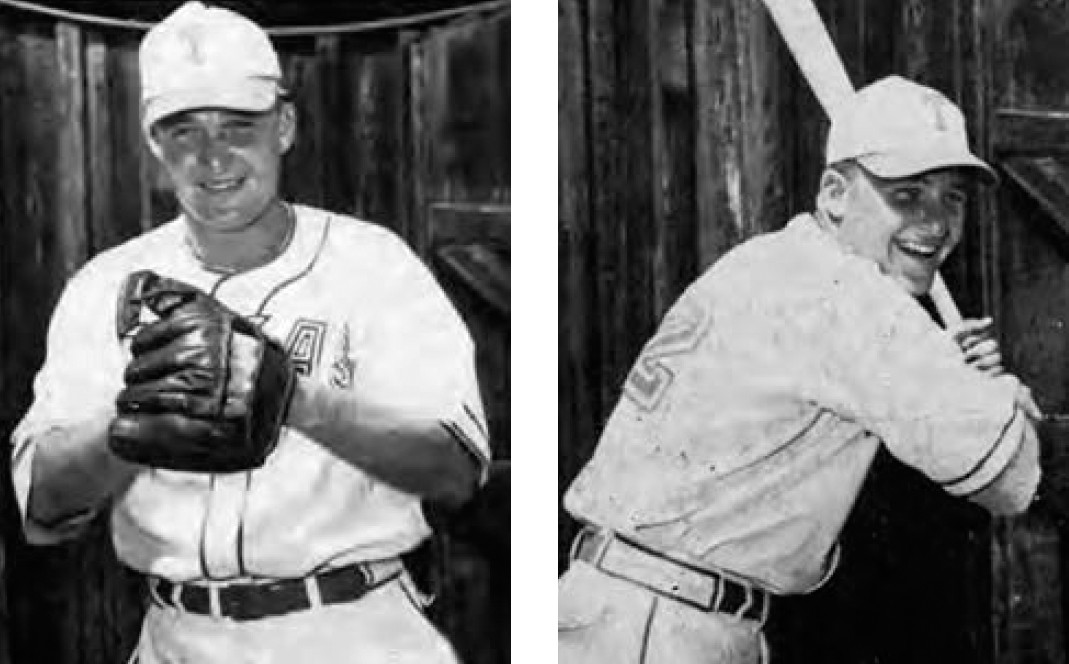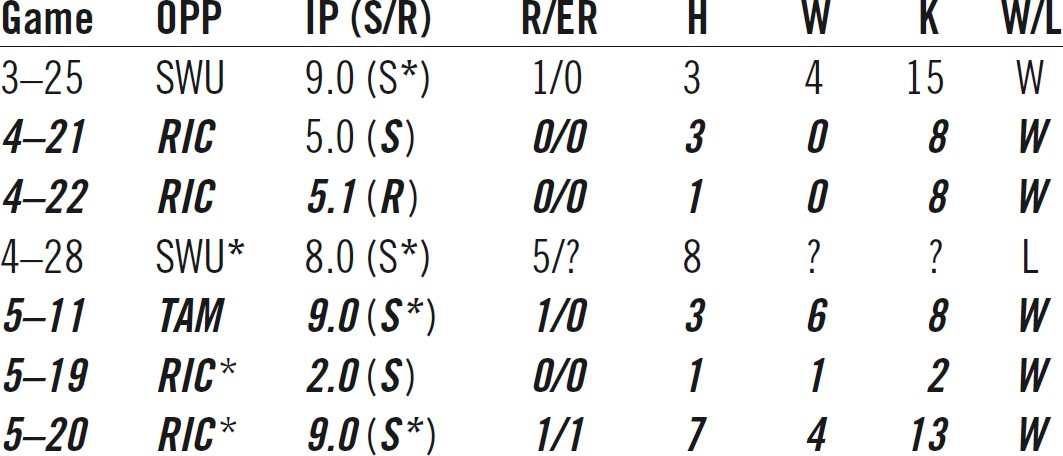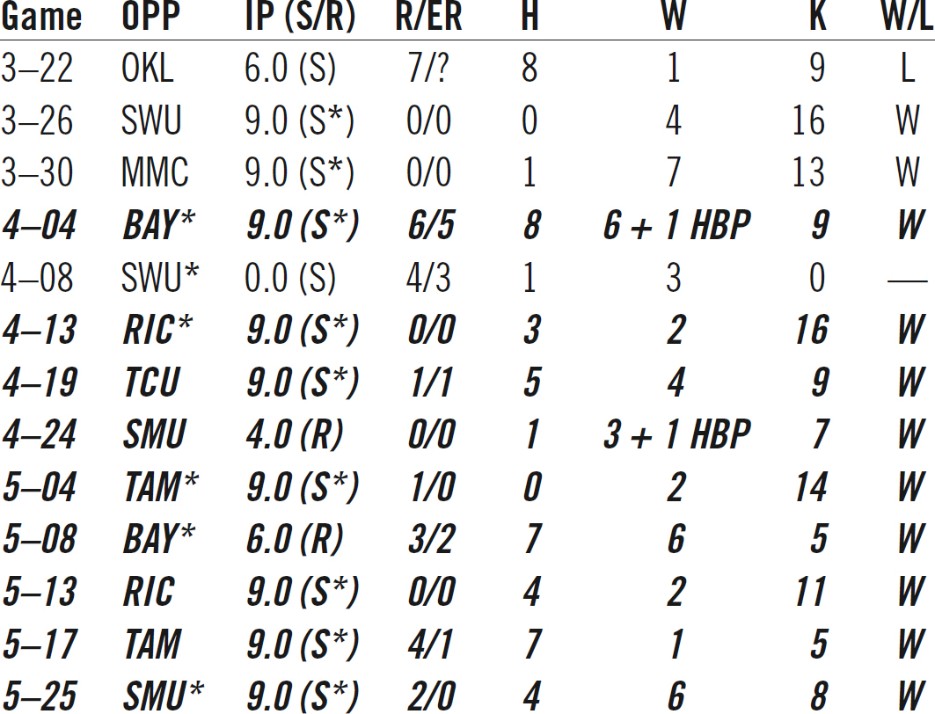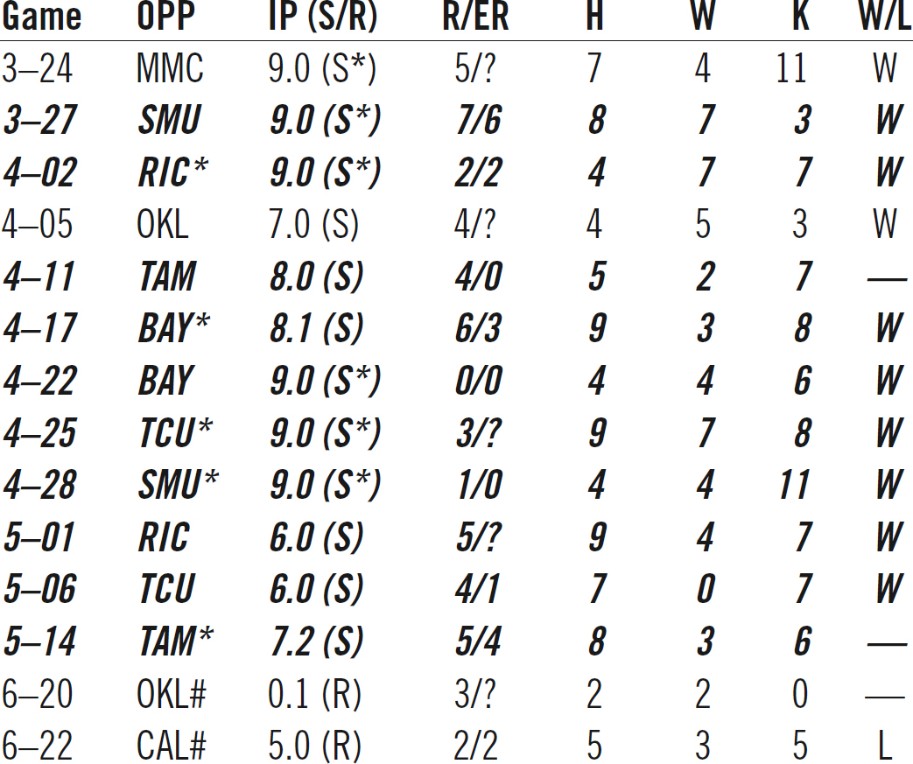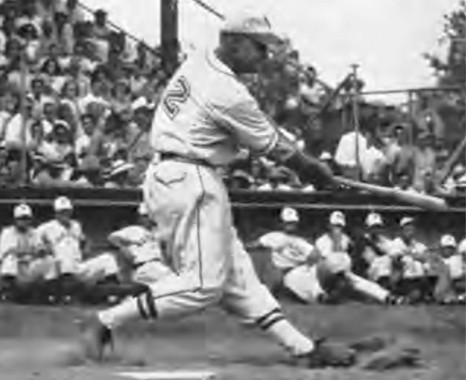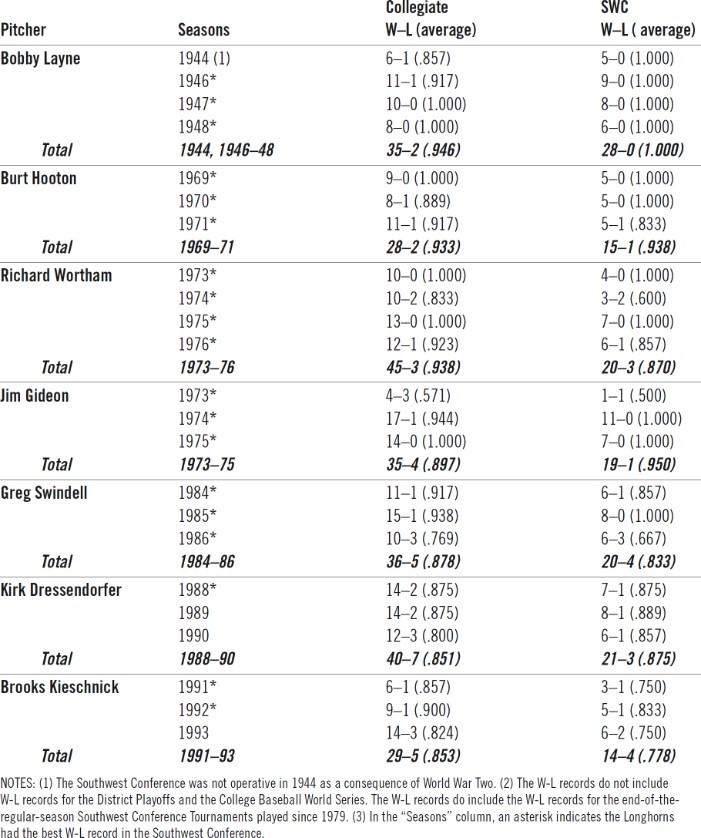Bobby Layne, 28-0: Hall of Fame Caliber Pitcher for the Texas Longhorns
This article was written by Herm Krabbenhoft
This article was published in The National Pastime: Baseball in Texas and Beyond (2025)
Bobby Layne is the only Longhorns pitcher to throw two nine-inning no-hitters, both in 1946—versus the Southwestern University Pirates (March 26) and the Texas A&M Aggies (May 4). (Texas Student Media/The Cactus)
During the 1944 and 1946-48 baseball seasons, while playing for the University of Texas Longhorns, Bobby Layne compiled an amazing 28-0 won-lost ledger vs. Southwest Conference teams. In doing so, Layne helped the team win the SWC championship in each of the latter three years.1
OBJECTIVES
The focus of this research is Bobby Layne’s phenomenal 28 consecutive victories versus the other five teams constituting the Southwest Conference: the Baylor University Bears, Rice University Owls, Southern Methodist University (SMU) Mustangs, Texas A&M Aggies, and Texas Christian University (TCU) Horned Frogs. The principal objectives are 1) to examine key details for selected games in the victory streak, and 2) assess how Layne’s achievement ranks now, some 75 years later.
RESEARCH PROCEDURE
Using Newspapers.com and Genealogy Bank, I searched newspapers for “Layne” in “Texas” from early March through mid-June (the time period covering the collegiate baseball seasons) for the years 1944 and 1946-48. In addition, I also examined the information presented in two biographies about Bobby Layne.2, 3
RESULTS
Brief summaries of every Longhorns baseball game Bobby Layne participated in are provided in Appendix A (available on the SABR website). Summaries for twelve of his games involving SWC teams are given here.
1944
April 21: Bobby Layne had his first SWC game versus Rice University. Layne tossed five innings of shutout ball, giving up but three hits, walking none and striking out eight. He took over in right field for the last four innings. Texas won the game, 5-0, with Layne being credited with the victory.4
May 19: Layne recorded another victory against Rice, even though he hurled only two innings (one hit, one walk, two strikeouts). Thanks to robust hitting, Texas built up an 11-0 lead going into the bottom of the third. Following the “Large Lead” custom, Layne was awarded the W as Texas defeated Rice by a final score of 16-12.5, 6
May 20: Thanks to his arm-saving short outing in the May 19 game, Layne was able to take the hill the very next day and hurl a complete game against the Rice Owls, emerging with a 7-1 triumph. Permitting only seven hits, Layne walked four batters and fanned 13.7, 8
For the 1944 season overall, Layne finished with a 7-5 W-L ledger. Excluding his 1-4 W-L record against non-collegiate opponents, such as teams composed of United States military personnel (such as servicemen stationed at the San Marcos Army Air Field), Bobby compiled a 6-1 ledger against collegiate foes. See Table 1.
Table 1. Bobby Layne’s Pitching Stats vs. Collegiate Opponents (1944)
NOTES: (1) The “OPP” column gives the opposing team. SWU (Southwestern University), RIC (Rice University), TAM (Texas A&M University). SWC teams in bold italics. An asterisk indicates the game was played at the opponent’s ballpark. (2) For the “IP (S/R)” column, “IP” gives the Innings Pitched; “S” indicates Starting pitcher and “R” indicates Relief pitcher. An asterisk indicates a complete game.
1946
After having spent much of 1945 in the Merchant Marine, Bobby Layne returned to the University of Texas in the fall and resumed pitching the next spring.
April 13: In his second outing of the season, versus Rice in Houston, Layne twirled a three-hitter and shut out the Owls, 16–0. Layne struck out 16 batters, the most in a single game during his college career.9
May 4: On May 1 the AP reported that “Bobby Layne, the Longhorns’ star pitcher, might not be able to start against the Texas A&M nine at College Station Saturday [May 4] because of an ankle injury.”10 Layne had suffered a badly bruised ankle in an automobile accident. But Layne did start the game and threw a no-hitter. Bobby struck out 14 Aggies and walked two as the Steers won a tight game, 2-1. The lone run came on a couple of fielding errors—batter Earl Beasley hit a grounder to third baseman Ransom Jackson and went all the way to second on the error. Beasley then “stole third and came home on a squeeze play when Layne threw wide to [catcher] Jack O’Reagan at the plate.” Bobby also did pretty well from the batter’s box, getting three singles in four trips to the plate.11
May 13: By twirling a four-hit 4-0 shutout against the Rice Owls, Layne and the Longhorns clinched the Southwest Conference championship. Layne struck out 11 and walked just two batters in the decisive victory.12
Overall, for 1946 Layne finished with a 12-1 W-L ledger. Excluding his three games against non-collegiate opponents (in which he went 1-0), Bobby produced an 11-1 ledger against collegiate foes. See Table 2.
Table 2. Bobby Layne’s Pitching Stats vs. Collegiate Opponents (1946)
NOTES: (1) See Table 1. (2) The “OPP” column gives the opposing team: OKL (Oklahoma University), MMC (McMurray College), BAY (Baylor University), TCU (Texas Christian University), SMU (Southern Methodist University).
1947
April 22: In front of the largest Clark Field crowd in history (estimated at 7,000), Layne outdueled Baylor’s Rickey Rowe in a minimum-run game, Layne himself tallying the only run. In tossing a 1-0 shutout, Layne surrendered only four hits and issued four walks; he struck out six. The Steers victory put them a half game ahead of the Bears in the race for the SWC championship.13
April 28: Layne turned in another solid mound performance, defeating the SMU Mustangs, 4-1. The only run he permitted was scored by his former high school teammate and future pro football teammate, Doak Walker, who received one of Layne’s four walks, which was followed by Layne’s fielding error on a grounder, and a timely single.14, 15
May 1: As reported in the Austin American, “The junior right-hander [Bobby Layne], who has never dropped a conference contest in three seasons of play, literally backed into this [win]. Ineffective and in trouble most of the time, Layne was replaced by Pinch Hitter George Schwoebel in the last of the sixth. The Steers had gone into the last half of that frame on the short end of a 5-2 score, but rallied to score five runs before a second Rice relief pitcher quelled the disturbance.” Charles Tankersley relieved Layne and the Longhorns’ 7-5 lead en route to an 8-6 win. Layne received credit for the win despite being smacked for nine hits and five runs, walking four and striking out seven.16
Overall, for the 1947 collegiate season, Layne finished with an 11-1 W-L ledger. Excluding his record against non-collegiate opponents (1-0), Bobby produced a 10-1 W-L ledger against collegiate foes. See Table 3.
Table 3. Bobby Layne’s Pitching Stats vs. Collegiate Opponents (1947)
NOTES: (1) See Notes in Tables 1 and 2. (2) The “OPP” column gives the opposing team—CAL (University of California, Berkeley). A hashtag indicates that the game was played in Denver, Colorado (NCAA Western Regional Playoffs).
Table 3 shows that Layne produced an 8-0 W-L ledger versus SWC teams and a 2-1 W-L record versus non-SWC teams. His only setback was in a relief role in the final game of the NCAA Western Regional Playoffs, five and a half weeks after his last SWC game. Appendix B (available on the SABR website) provides pertinent information on Layne’s non-collegiate diamond activity during that interval and his performance in the Western Regional Playoffs.17
Bobby Layne takes a swing in this photo from the 1948 University of Texas Yearbook. (Texas Student Media/The Cactus)
1948
April 9: After TCU had raked Layne in the top of the first for three runs on four hits, the Longhorns responded with a six-run outburst, capped off by Layne himself. “Joe Randerson doubled and Al Hunt brought him home with a single. Shortstop Chick Zomlefer, who was sensational in the field, then hit a double and [after Tom Hamilton was retired] Hobbs Williams reached first when he was hit by a pitched ball. Hunt and Zomlefer scored on a single by Charlie Munson. [The next batter, Don Russell, was retired.] With two out and two men [Williams and Munson] on base and two men out [and three runs already in], the TCU board of strategy elected to issue Dan Watson an international [sic] base on balls in order to get to Layne. The Blond Bomber responded in typical Layne fashion, slapping out a single—his first hit of the season—to score Williams, [Munson], and Watson [giving the Longhorns a 6-3 lead].”18 However, with the Steers ahead, 6-4, after four frames, Layne could not survive the fifth inning: “Layne was relieved early in the fifth after Rick Kramer walked and Jim Busby hit his circuit clout.”19 Layne was rocked for six earned runs on eight hits before being relieved by Murray Wall, who earned the win, 7-6.
April 23: Bobby Layne earned his second consecutive shutout by hurling a 3-0 complete game over the Rice Owls. Layne tossed a three-hitter while fanning fifteen.20, 21
May 14: Going into the final two-game series of the season between the first-place Longhorns (with an SWC record of 11-1) and the second-place Aggies (11-2), Texas needed to win just one of the games to claim at least a tie for the SWC championship.22 Not surprisingly, Bobby Layne was chosen by Steers’ manager Bibb Falk to start the first game. Layne did the job as Texas won the game, 16-4. Layne allowed nine hits and walked four while striking out six, and carving out his 28th SWC victory without a defeat.23 Texas then claimed the SWC championship outright for the fourth straight season by winning the second game, 3-2.24
Overall, for the regular 1948 collegiate season, Layne finished with a 9-0 W-L ledger. Excluding his record against non-collegiate opponents (1-0), Bobby produced an 8-0 W-L ledger against collegiate foes. See Table 4. Thus, Layne extended his streak of consecutive regular-season wins versus collegiate teams to 29.
Table 4. Bobby Layne’s Pitching Stats vs. Collegiate Opponents (1948)
NOTES: The “OPP” column gives the opposing team—OSU (Ohio State University). See also the Notes in Tables 1 and 2.
SUMMARY
As shown in Table 5, during the 1944 and 1946-48 diamond campaigns the Texas Longhorns fashioned an overall regular-season W-L ledger of 68-20 (.773). Versus collegiate teams, the Steers compiled a 63-8 (.887) W-L record. The 17 Longhorns’ games versus non-collegiate teams included military service clubs (10), an industrial team (1), and minor league clubs (6). Against SWC foes the Steers assembled a 47-3 (.940) W-L record. Layne’s corresponding W-L stats [39-6 (.867), 35-2 (.946), and 28-0 (1.000)] clearly show that he was the top of the hill.
Table 5. Regular-Season W-L Records for Texas and Bobby Layne (1944, 1946-1948)
NOTE: Including Texas’s 1–1 W-L record for the 1947 post-season (NCAA Western Regional Playoffs) gives Texas an overall record of 69–21 (.767) and a collegiate record of 64–9 (.876); Layne had an 0–1 W-L record which gives him an overall record of 39–7 (.848) and a collegiate record of 35–3 (.921).
Layne pitched in 31 (62%) of the Longhorns 50 SWC games. Layne was the game-starting hurler 28 times, and won 25 of them, 20 as complete games. The Longhorns also won each of the three games in which he had a no-decision. Layne came in from the bullpen in three games and earned the win each time. Pertinent information for the seven Texas pitchers who started the other 22 SWC regular-season games is given in Appendix C (available on the SABR website).
Also of significance, based on my research, Bobby Layne concluded his collegiate career with a streak of 29 consecutive regular-season victories. According to the baseball records information provided on the NCAA website, the longest streak for consecutive victories by a Division 1 pitcher is 26, shared by Kyle Sleeth (Wake Forest, 2001-03) and Scott Nielse (Brigham Young University, 1978, 1982-83).25 The following introductory/explanatory note was also provided: “Official NCAA Division I baseball records began with the 1957 season and are based on information submitted to the NCAA statistics service by institutions participating in the statistics rankings. Career records of players include only those years in which they competed in Division I.” Thus, Bobby Layne’s record of 29 consecutive regular-season triumphs versus collegiate teams—achieved from March 26, 1946, through May 14, 1948—is three games longer than the post-1956 record of 26 given in the NCAA record book. In Table 6 we will examine how Layne compares to six members of the College Baseball Hall of Fame.
Table 6. Annual Regular-Season Collegiate Pitching Stats for Bobby Layne and Six College Baseball Hall of Famers (from the University of Texas)
NON-PITCHING, NON-COLLEGE AND NON-BASEBALL CAREER
Bobby Layne was also a star quarterback on the gridiron, both in college and in the National Football League. He led the football Longhorns to New Year’s Day triumphs in 1946 (Cotton Bowl) and 1948 (Sugar Bowl), and sparked the Detroit Lions to four Division titles and three NFL Championships (1952, 1953, and 1957). With regard to Bobby Layne’s performance as a batter and as a fielder during his college years, Appendix D (available on the SABR website) provides the pertinent information on a game-by-game basis for his SWC games. His fielding average was .950. Overall for his SWC games, Layne manufactured a triple-slash line of .224/.333/.255, demonstrating that he hit neither for average nor power. Layne hit only one home run while hurling for the Longhorns. In a March 24, 1947, game versus the McMurray College Indians, Layne tossed a complete-game seven-hitter as the Steers won, 9-5. “Blond Bobby contributed a home run over the right field fence [at Clark Field] in the seventh inning for the Longhorns’ final run.”26
Prior to beginning his professional football career with the Chicago Bears in the fall of 1948, Layne also played professional baseball. While Layne’s collegiate pitching career was stellar, his brief time as a professional baseball player—a dozen games for the Lubbock Hubbers (Class C West Texas New Mexico League) between June 11 and July 25, 1948—yielded mediocre performance stats. As given in the 1949 edition of Official Baseball Guide (published by The Sporting News), Layne fashioned a 6-5 W-L pitching ledger with an ERA of 7.29. He struck out 74 and walked 55. Appendix E (available on the SABR website) provides game-by-game information for Layne’s professional baseball career.
CONCLUDING REMARKS
Not surprisingly, Bobby Layne’s name is best remembered for his football accomplishments. Layne is enshrined in both the College Football Hall of Fame (1968) and the Pro Football Hall of Fame (1967). However, it seems curious, if not incredible, that Layne is not in the College Baseball Hall of Fame. The Texas Longhorns have had six pitchers elected—Brooks Kieschnick (2006), Burt Hooton (2008), Greg Swindell (2008), Kirk Dressendorfer (2009), Richard Wortham (2010), and Jim Gideon (2020). Table 6 provides pertinent performance stats for each of these pitchers.27
HERM KRABBENHOFT is a retired chemist (PhD, University of Michigan, 1974) and author of Leadoff Batters of Major League Baseball (McFarland, 2001). Among the various baseball research topics he has pioneered are: Ultimate Grand Slam Homers, Consecutive Games On Base Safely (CGOBS) Streaks, Quasi-Cycles, Imperfect Perfectos, Downtown Golden Sombreros, and Pitcher’s Cycles. In addition to The National Pastime and the Baseball Research Journal, Herm has contributed articles to the newsletters for SABR’s 19th Century, Deadball Era, Statistical Analysis, and Baseball Records Committees. Krabbenhoft has received three SABR Baseball Research Awards (1992, 1996, 2013).
Acknowledgments
Special thanks to Kevin Rodriguez (University of Texas Athletics, Associate Director, Communications), David Lentz (NCAA, Assistant Director of Media Coordination and Statistics), and Sean Straziscar (NCAA). For permission to use pictures of Bobby Layne, grateful thanks are extended to Emily Cohen (Director for Marketing and Advertising, University of Texas at Austin) and Richard Tijerina (Sports Editor) and Briana Sanchez (Director of Photography) with the Austin (Texas) American Statesman. Thanks also to Karl Green, Jeff Robbins, Gary Stone, Patrick Todgham, and Dixie Tourangeau for valuable inputs/discussions.
Notes
1. Texas Longhorns, 2023 Baseball Fact Book, 87, https://s3.us-east-2.amazonaws.com/sidearm.nextgen.sites/texassports_com/documents/2023/2/15/23-fact-book-FULL-web.pdf, accessed October 1, 2024. The Southwest Conference was not operative in 1944 as a consequence of World War II.
2. Bobby Layne with Bob Drum, Always On Sunday (Prentice Hall, 1962).
3. Bob St. John, Heart of a Lion—The Wild and Wooly Life of Bobby Layne (Taylor Publishing Co, 1991).
4. Morris Williams, “Longhorns Take First of 2 Games With Rice, 5-0,” Austin American, April 22, 1944, 7.
5. “Layne Builds Up 11-Run Lead And Retires,” Austin American, May 20, 1944, 7.
6. The “Large Lead” custom: Pete Palmer, email to the author, November 2, 2023: “If you leave the game with a large lead, you can get the win because the manager is saving you for the next game. I don’t know when that practice was in effect. There were no [official] rules for ‘winning’ and ‘losing’ pitchers until 1950.” For an example, see Herm Krabbenhoft, “The Pitcher’s Cycle,” SABR Baseball Research Journal (Volume 53, Number 2, Fall 2024) page 34—Christy Mathewson was relieved after the first inning with the New York Giants leading the St. Louis Cardinals 13-0. “Having the game in hand, [manager John] McGraw took Mathewson out of the box, so as to save him for another game and he put [Rube] Marquard in the box.” [“Did Anyone See Bresnahan’s Goat?,” The (New York) World, Evening Edition, May 13, 1911, 11]. The Retrosheet box score shows Mathewson having been credited as the winning pitcher and Marquard having earned a save. See also: Frank Vaccaro, “Origin of the Modern Pitching Win,” Baseball Research Journal (Volume 42, Number 1, Spring 2013) 50; Frank J. Williams, “All the Record Books Are Wrong,” The National Pastime, 1982, 50; Joe Wayman, “The Matty-Alex Tie,” Baseball Research Journal (Number 24, 1995) 25.
7. “Longhorn Nine Takes Second Game From Rice,” Austin American, May 21, 1944, 12.
8. Johnny Lyons, “Texas Wins, 7-1, on Six Unearned Runs,” Houston Post, May 21, 1944, Section 2, 3.
9. “Layne Pitches Three-Hitter, Fans 16 Owls,” Austin American, April 14, 1946, 18.
10. “Bobby Layne May Not Start Against Aggies Saturday,” [AP] Amarillo (Texas) Daily News, May 2, 1946, 10.
11. Wilbur Evans, “Layne Pitches No-Hitter as Texas Tops A&M, 2-1,” Austin American, May 5, 1946, 17.
12. Wilbur Evans, “Steer Nine Takes Title…Layne Scores Seventh Win in Blanking Rice,” Austin American, May 14, 1946, 7.
13. Morris Williams, “Bears Fall to Longhorns, 1-0,” Austin American, April 23, 1947, 11.
14. Harry Gage, “Steers Down SMU Nine by 4-1 Margin,” Dallas Morning News, April 29, 1947, 10; “Layne Stops SMU with 4 Hits, 4-1,” Austin American, April 29, 1947, 9.
15. Bobby Layne and Doak Walker were classmates at Highland Park High School in University Park, Texas (just north of Dallas) and teammates on the Detroit Lions (1950-55) during which they led the Lions to three Division Titles and two NFL Championships. In their college years at Texas and SMU they squared off mano-a-mano in four baseball games: (1) March 27, 1947: playing left field and batting leadoff, Walker went 0-for-4 with a walk against Layne. (2) April 28, 1947: playing left field and batting leadoff, Walker went 1-for-4 with a single and a walk. (3) April 13, 1948: playing center field and batting leadoff, Walker went 1-for-4 with a single. (4) May 7, 1948: playing center field and batting second, Walker went 0-for-3 with a sacrifice hit.
16. Wilbur Evans, “Steers Nip Rice, 8-6,” Austin American, May 2, 1947, 17.
17. Layne’s postseason loss to California snapped a streak of 21 consecutive victories vs collegiate teams. However, adhering to the official rules of Major League Baseball for “Cumulative Performance Records” (Rule 9.23), his streak of 21 straight regular-season triumphs remained intact: “Guidelines for Cumulative Performance Records (Rule 9.23),” Official Baseball Rules, 2024 Edition, 144. See, for example: Matt Kelly, “Pitchers with the longest win streaks,” https://www.mlb.com/news/the-longest-pitcher-win-streaks-in-mlb-history, August 25, 2020 (accessed October 17, 2024)—”(1) Carl Hubbell, 24 straight wins (July 17, 1936, to May 27, 1937); (2) Roy Face, 22 straight wins (June 7, 1958, to August 30, 1959); (3-Tied) Gerrit Cole 20 straight wins, (May 27, 2019, to August 14, 2020); (3-Tied) Jake Arrieta (August 4, 2015 to May 25, 2016); (3-Tied) Roger Clemens (June 3, 1998 to June 1, 1999); (3-Tied) Rube Marquard October 1, 1911 to July 3, 1912).” Kelly also provided this: “NOTE: These streaks do not include postseason appearances, which means that Cole’s loss to the Nats in Game 1 of last year’s World Series [i.e., 2019] did not preclude him from [possibly tying] Hubbell’s record.”
18. Jimmy Banks, “Longhorns Edge TCU,” Austin American, April 10, 1948, 8. It is noted that the box score in the Austin American shows Layne with three RBIs, suggesting that Layne’s single knocked in the three runners on base (Williams, Munson, and Watson). However, an AP article describing the first inning suggested that an error was involved in the scoring of the six runs: Associated Press, “3 Tilts Today in SWC Loop,” San Antonio Evening News, April 10, 1948, 5: “Texas erased a three-run Frog lead in the bottom half of the first with a six-run splurge on five hits and an error.” Thus, considering both the Austin American account and the AP story, it seems that the five of the six runs were scored on five hits—Randerson (who had doubled) scored on Hunt’s single; Hunt and Zomlefer (who had doubled) scored on Munson’s single; Willams and Munson scored on Layne’s single—and that Watson scored on an error in the fielding of Layne’s single, the Austin American box score generously giving Layne RBI credit for the run scored by Watson. According to the Austin American box score, TCU committed three errors and five of Texas’s seven runs were earned runs. Texas’s seventh run in the bottom of the fifth inning, scored by Russell, was also unearned, although no details were provided in the game story.
19. “Frogs Chase Layne But Lose,” Houston Post, April 10, 1948, 8.
20. Morris Frank, “Layne Says Farewell to Rice, 3-0,” Houston Post, April 24, 1948, 13.
21. “Steers Defeat Rice, 3-0…Layne Pitches Three-Hitter for 25th Win,” Austin American, April 24, 1948, 6.
22. The various scenarios resulting from the two-game Steers-Aggies series were as follows: (a) If Texas wins both games, Texas is the SWC champion outright. (b) If Texas A&M wins both games, Texas A&M is the champion outright. (c) If the Longhorns and the Aggies each win one game, then Texas will have to go back to Fort Worth and play the TCU game that was rained out May 10. If Texas wins that game, it is the SWC champion outright; if TCU wins that game, then the Longhorns and Aggies would tie for the SWC title (although Texas could claim bragging rights since it would have won two of the three games between the two clubs).
23. Weldon Hart, “16-4 Triumph Clinches Title Tie for Steers,” Austin American, May 15, 1948, 7.
24. Despite winning the SWC championship, the University of Texas decided to remove itself from consideration to be the sixth district representative in the NCAA tournament for the 1948 College Baseball World Series. Longhorns’ manager Bibb Falk said, “Graduation of four first-stringers, including pitcher Bobby Layne and shortstop Chick Zomlefer, would require a makeshift lineup if we went to the tournament. Summer school, one or two boys’ professional plans, and the length of time between the end of our season and the tournament all add up.” From “Longhorn Nine Out…Steers Shun NCAA Bid,” Austin American, May 15, 1948, 19.
25. NCAA Division 1 Baseball Records, Individual Records: Pitching: Victories, Consecutive, page 3, http://fs.ncaa.org.s3.amazonaws.com/Docs/stats/baseball_RB/D1.pdf, accessed October 22, 2024.
26. Morris Williams, “Layne Stingy as McMurray Falls to Longhorns, 9-5,” Austin American, Marc 24, 1947, 11.
27. The performance stats for the pitchers included in Table 6 were ascertained from the box scores and game accounts in relevant newspapers for each of Texas’s regular-season games in the seasons the pitchers played for Texas. The identities of the Texas pitchers elected to the College Baseball Hall of Fame were obtained from the list of “Hall of Fame Honors” section (page 161) in the Texas Longhorns, 2023 Baseball Fact Book. The dates and opponents of Texas’s pertinent regular-season games were obtained from the “Year-By-Year Results” section (pages 81-104) and the “Year-By-Year Conference Standings” section (pages 109-15) in the Texas Longhorns, 2023 Baseball Fact Book.


